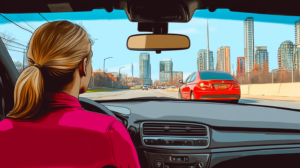Can You Drive on the Highway with a G2 Licence?
More help for you
Canada is the second-largest country in the world, with an area of 10 million square kilometres. Most of it is covered by natural features, especially in the northern regions where the environment can be harsh. Despite these challenges, a network of roads connects every province and territory except for Nunavut. With a G1 licence, you could drive on all of them except highways and expressways. (In this paper, we’re using the term “highway” in its colloquial sense of a controlled-access highway. This sense should not be confused with the legal term “highway” in the Ontario Highway Traffic Act, which is defined as any public roadway, even a country road.)
This restriction is lifted once you obtain a G2 licence, which allows you to finally cruise down the highway without being under the supervision of an official driving instructor.
400-series Highways
In Ontario, the 400-series highways connect cities, towns and villages in the southern part of the province. They are part of the King’s Highways, the primary provincial highway system. You can compare them to interstate highways in the United States or the Autobahn in Germany.
These highways typically have speed limits ranging from 100 km/h to 110 km/h, which is fast enough for drivers to experience tunnel vision. It is a visual effect that narrows a person’s field of view, making it difficult to detect changes in the peripheral view.
Because of their lack of driving experience, G1 drivers are not allowed to drive on these roads without the supervision of a driving instructor. Reflexes and muscle memory can only develop with practice, which is why only G2 and full G drivers can use 400-series highways where the speed limit exceeds 80 km/h. With a G2 licence, you already have at least eight months of driving experience, during which you have learned to control a vehicle in various conditions.
Access to 400-series highways is managed through on-ramps and off-ramps, with no direct access otherwise. Instead of intersections, these roads have interchanges that are easy to navigate, though beginners might struggle with disorientation. Because of their lack of experience on these roads, G2 holders should seriously consider driving under supervision at first, even though it is not legally required.
Expressways
While all 400-series highways are expressways, not all expressways in Ontario are part of the 400-series. These roads were built to facilitate faster travel over long distances all across the province. If 400-series highways can only be found in the southern part, expressways are everywhere.
The northernmost community connected to a highway is Pickle Lake, located at the end of Highway 559. Other examples of non-400-series expressways include the Don Valley Parkway (DVP) and the Frederick G. Gardiner Expressway, both located in Toronto.
Restrictions for 400-series highways also apply to all expressways in the province, so G2 drivers have unlimited access to these roads while G1 licence holders will need the supervision and approval of an official instructor.
Can I Drive on the Trans-Canada Highway?
The Trans-Canada Highway is a major route that spans the entire country, connecting all ten provinces. It is one of the busiest roads on the North American continent, which makes it dangerous for beginner drivers. G1 licence holders are prohibited from entering this major highway without a driving instructor.
This scenic highway stretches over 7,476 kilometres, from the easternmost point at St John’s in Newfoundland and Labrador all the way to Victoria in British Columbia. Although the highway is well-maintained, it traverses a variety of terrains. Harsh winter conditions, mountainous routes and even wildlife crossings make the Trans-Canada Highway more suitable for experienced drivers.
G2 licence holders can drive on this highway alone, but they are not required to. You can still benefit from the supervision of an expert driver who is ready to take over if something goes wrong. You should never drive unsupervised on any highway if you are not confident in handling a vehicle at higher speeds.
International Highways
While a G2 licence allows you to cross the border and drive internationally, many countries also require an International Driver’s Permit (IDP). Since your driver’s licence allows you to drive on Canadian highways and expressways, this privilege also transfers to your IDP.
If you are planning on crossing the border and going on a road trip with your friends, note that you won’t need an IDP to drive in the US or Mexico. Anyone with a G2 driver’s licence can legally drive on those countries’ highways.
After obtaining an IDP, you can also drive on the highways in countries that require it. While this is a general rule that allows G2 licence holders to drive on these roads, it is advisable to check the specific regulations for the country you are visiting. And G2 holders should consider waiting until they get more driving experience before attempting to drive in a foreign country with different rules of the road.



